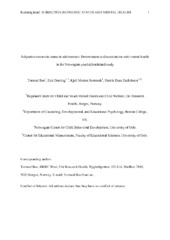| dc.contributor.author | Bøe, Tormod | |
| dc.contributor.author | Dearing, Eric | |
| dc.contributor.author | Stormark, Kjell Morten | |
| dc.contributor.author | Zachrisson, Henrik Daae | |
| dc.date.accessioned | 2018-03-02T12:14:07Z | |
| dc.date.available | 2018-03-02T12:14:07Z | |
| dc.date.issued | 2017 | |
| dc.Published | Bøe T, Dearing E, Stormark KM, Zachrisson HD. Subjective economic status in adolescence: determinants and associations with mental health in the Norwegian Youth@Hordaland Study. Journal of Family and Economic Issues. 2017 | eng |
| dc.identifier.issn | 1058-0476 | |
| dc.identifier.issn | 1573-3475 | |
| dc.identifier.uri | https://hdl.handle.net/1956/17483 | |
| dc.description.abstract | We aimed to identify factors associated with perceived economic well-being (PEWB), and examine its association with symptoms of depression and attention-deficit/hyperactivity disorder. In the Norwegian youth@hordaland study, 9166 16–19-year-olds provided information on perceived economic well-being and relevant covariates. Information about families’ income-to-needs was obtained from tax return forms. Adolescents in households with a low income-to-needs ratio, with non-working parents, and in single-parent households were more likely to report poor PEWB. Adolescents with poor PEWB reported more symptoms of depression and ADHD, also after adjusting for covariates, including income-to-needs. There was a significant indirect effect of income-to-needs on mental health problems though PEWB. The current study demonstrates the role of PEWB as a contributor in the pathway from social inequalities to disparities in mental health. | en_US |
| dc.language.iso | eng | eng |
| dc.publisher | Springer | eng |
| dc.subject | ADHD | eng |
| dc.subject | Adolescents | eng |
| dc.subject | Depression | eng |
| dc.subject | Income | eng |
| dc.subject | Social inequality | eng |
| dc.subject | Income | eng |
| dc.title | Subjective economic status in adolescence: determinantsand associations with mental health in the Norwegian Youth@Hordaland Study | eng |
| dc.type | Peer reviewed | |
| dc.type | Journal article | |
| dc.date.updated | 2018-01-31T13:37:30Z | |
| dc.description.version | acceptedVersion | |
| dc.rights.holder | Copyright Springer Science+Business Media, LLC 2017 | eng |
| dc.identifier.doi | https://doi.org/10.1007/s10834-017-9553-4 | |
| dc.identifier.cristin | 1510707 | |
| dc.source.journal | Journal of Family and Economic Issues | |
